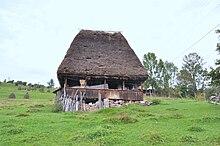Motzenland

The Motzenland (Romanian Țara Moților ) is a cultural and ethnogeographical region in western Transylvania in Romania .
location
The Motzenland is located in the Apuseni Mountains on the upper reaches of the Arieș River . It is part of the Bihor , Vlădeasa , Gilău , Muntele Mare , Trascău and Metaliferi mountains . The exact extent is controversial. The cultural center is the city of Câmpeni ( Topesdorf ).
Surname
The region is named after its inhabitants, the Motzen (Romanian moți ). The ethnological assignment of these motifs is not certain. In Romania they are mostly seen as direct descendants of the Dacian indigenous people. According to other views, the Motzen immigrated to the mountainous country in later centuries and do not differ ethnologically from the other Romanians .
Michael Lebrecht was one of the first authors to use the term "Motzen" in his work "On the National Character of the Nations in Transylvania" in 1792. According to one thesis, “moți” is derived from the Romanian word “moț” (German “tufts of hair” or “tuft”), which used to be the traditional hairstyle of men in the region.
history
During the Habsburg Monarchy, the Motzen lived in the interior of the Apuseni Mountains as free subjects of the emperor; in the outskirts of the mountains they were mostly servants of Hungarian landlords. They saw themselves as "the emperor's men" and regularly took the former side in the event of a conflict between the Austrian imperial family and the Hungarians of the monarchy.
Two historical events play an essential role in the identity of the Motzen: In 1784 Motzen and other Romanian farmers under Horea rose against the Hungarian landlords, before the uprising was suppressed by Austrian troops with some delay. During the revolutionary years of 1848/49 , when Hungary tried to break away from Austria, numerous Motzen under their leader Avram Iancu successfully fought the Hungarian revolutionary troops with partisan tactics and thus became direct allies of the Austrian emperor. Numerous atrocities were committed on both sides during these battles.
Population and economy
The Motzenland is characterized by fairly closed villages in the valleys and numerous scattered settlements in the mountains. These extend up to an altitude of 1400 meters and are therefore the highest permanently inhabited properties in Romania. Because of the unfavorable infrastructural conditions, the region has been affected by a sharp decline in population since the 1960s, which is particularly evident in the higher mountain hamlets.
The residents mainly deal with forestry and grazing. Timber crafts and mining are in decline. In addition, tourism is playing an increasing role.
Individual evidence
- ^ M. Wedekind: Scientific milieus and ethnopolitics in Romania in the 1930s / 40s. In: J. Ehmer et al. (Ed.): Challenge population. VS-Verlag 2007. ISBN 3-531-15556-3 .
- ↑ (ed.): IA Goia, Z. Borlan settlement history of the villages in the "Pimp Land" (Ţara Moţilor) in E. Ruşdea, A. Reif, I. Povara and W. Konold: perspectives for a traditional cultural landscape in Eastern Europe - Results of an inter- and transdisciplinary, participatory research project in the Apuseni Mountains in Romania (August 2004), Culterra Vol. 34, Freiburg 2005
- ^ I. Lăzărescu, E. Savin: Langenscheids Universal Dictionary Romanian, revision. Berlin 1998.
- ^ Heinrich Ritter von Levitschnigg: Kossuth und seine Bannerschaft: Silhouettes from the post-March in Hungary, Volume 2. Verlag Heckenast, Pest 1850. P. 305.
- ↑ KM Pataky: Bem in Transylvania: On the history of the Hungarian war 1848 u. 1849. Otto Wigand publishing house, Leipzig 1850. P. 73ff.

